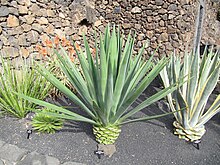
Yucatán, officially the Free and Sovereign State of Yucatán, is one of the 31 states which, along with Mexico City, constitute the 32 federal entities of Mexico. It comprises 106 separate municipalities, and its capital city is Mérida.

Sisal is a species of flowering plant native to southern Mexico, but widely cultivated and naturalized in many other countries. It yields a stiff fibre used in making rope and various other products. The sisal fibre is traditionally used for rope and twine, and has many other uses, including paper, cloth, footwear, hats, bags, carpets, geotextiles, and dartboards. It is also used as fibre reinforcements for composite fibreglass, rubber, and concrete products. It can also be fermented and distilled to make mezcal.

Yucca is a genus of perennial shrubs and trees in the family Asparagaceae, subfamily Agavoideae. Its 40–50 species are notable for their rosettes of evergreen, tough, sword-shaped leaves and large terminal panicles of white or whitish flowers. They are native to the Americas and the Caribbean in a wide range of habitats, from humid rainforest and wet subtropical ecosystems to the hot and dry (arid) deserts and savanna.

Mezcal, sometimes spelled mescal, is a distilled alcoholic beverage made from any type of agave.

Sisal is a seaport town in Hunucmá Municipality in the state of Yucatán, Mexico. It was the principal port of Yucatán during the henequen boom, later overshadowed when the more modern port of Progreso was built to the east. It lent its name to the agave-derived sisal fiber which was shipped through this port.

Dasylirion is a genus of succulent, rosette-forming plants in the Asparagaceae family. Most species are native to mountainous arid regions of Mexico, with some species also native to the Southwestern United States. The common name sotol is used in English and Spanish to describe various Dasylirion species, as well as giving its name to a distilled spirit called sotol made from some species of the genus.

Agave is a genus of monocots native to the arid regions of the Americas. The genus is primarily known for its succulent and xerophytic species that typically form large rosettes of strong, fleshy leaves.
José María Lanz y Zaldívar was a Spanish-Mexican mathematician and engineer. Together with Agustín de Betancourt, he developed the classification of mechanisms begun by Jean Nicolas Pierre Hachette, and counts as one of the founders of industrial kinematics.

Nicolás Cámara Vales was a Mexican liberal politician, diplomat and physician who served as governor of Yucatán on two occasions between 1911 and 1913 during the early stages of the Mexican Revolution. He was also the brother-in-law of José María Pino Suárez, who held the position of vice president of Mexico during the same period.
José Tiburcio López Constante was governor of Yucatán, Mexico.
The Villajuana family are Mexican artisans specializing in hammocks from Euan, Tixkokob, Yucatán in southern Mexico. Their work has been recognized by being named “grand masters” by the Fomento Cultural Banamex.

Hacienda Santa Rosa de Lima is located in Maxcanú Municipality, Yucatán, Mexico, about 60 km from the city of Mérida. It is one of the properties that arose during the henequen boom, and produced sisal for many years. The property, which was largely completed in 1909, is now an exclusive luxury hotel.

The Henequen industry in Yucatán is an agribusiness of a plant native to Yucatán, Mexico. After extraction from the plant, henequen is processed as a textile in various forms to obtain a range of products for domestic, commercial, agricultural and industrial use. It was exported to America as binder twine for crops in large quantities, and worldwide as rope for mooring ships, cloth for sacks, and other uses. It was a major regional industry from the time of the Maya civilization until the mid 20th century. The invention of synthetic fibers and the manufacturing of substitute products from these displaced henequen and sisal fibers and led to the decline of the industry over the course of the 20th century.
Haciendas of Yucatán were agricultural organizations that emerged primarily in the 18th century. They had a late onset in Yucatán compared with the rest of Mexico because of geographical, ecological and economical reasons, particularly the poor quality of the soil and lack of water to irrigate farms. Commonly the farms were initially used exclusively for cattle ranching, with a low density of labor, becoming over time maize-growing estates in the north and sugar plantations in the south, before finally becoming henequen estates.

Hacienda Cacao is located off the Carretera Uman-Hopelceh within Abalá Municipality, Mexico, and is in the South West Region 8 area of the State of Yucatán. It is one of the properties that arose during the nineteenth century henequen boom, and was owned by José María Ponce.

Hacienda Eknakán is located in the Cuzamá Municipality in the state of Yucatán in southeastern Mexico 48 kilometers southeast of the city of Mérida, between the towns of Acanceh and Cuzamá. It is one of the properties that arose during the nineteenth century henequen boom. It is unusual in that it was built with the plan to become a religious center around its church.

Hacienda Santa Cruz Palomeque is located in the Mérida Municipality in the state of Yucatán in southeastern Mexico. It is one of the properties that arose during the nineteenth century henequen boom. It is part of the Cuxtal Ecological Reserve which was set aside in 1993 to protect both the man-made and natural history of the reserve area of Mérida.

The House ofCámara is an aristocratic family with a rich history in Spain, Portugal and Mexico.

The divine caste, known as "la casta divina" in Spanish, refers to a group of wealthy and influential families in the Yucatán Peninsula during the 19th and early 20th centuries. They were considered the social and intellectual elite of the region and held significant cultural, political, and economic power.

Raymundo Cámara Luján was a prominent Mexican entrepreneur, banker, landowner, and philanthropist who played a significant role in the economic expansion that the Yucatán Peninsula experienced in the late 19th and early 20th centuries.



















